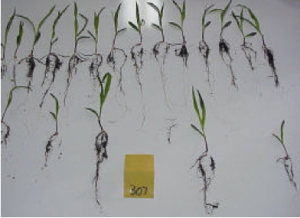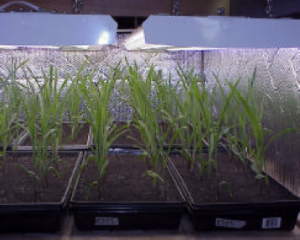Tray studies in the lab provide for short term efficacy on product candidates. Studies are done with a spectrum of light from regular and grow-light sources of fluorescent light. The small plants are typical to those in the field and usually take the plants to 12 inches in height. This is a means to evaluate starters, herbicides, and growth promoters on early plant emergence and growth. Typically three or more replications of treatments are included with randomized complete blocks so effects within the growth areas can be blocked out. The lights are set on spring-time light intervals and temperatures kept within typical growing ranges. The trays are filled with six inches of sieved silt loam soil with a water catch tray under each tray. A uniform amount of water is added to each tray to approach field capacity. Measurements include heights, dry weights of tops, vigor and color ratings, and plant counts.

Off season crop growth evaluations for early plant development provide indicators for field test protocols. The analysis of measurements is done statistically with the ARM (agricultural research manager) program from Gylling and results can be sent electronically and converted to excel as needed if someone is not using ARM. Root ratings and weights can be done as well as determining the loss of water from each tray. Water stress can be applied by varying the amount of measured water provided to the trays. Applications of growth promoters or hormones can be evaluated for enhanced emergence.


